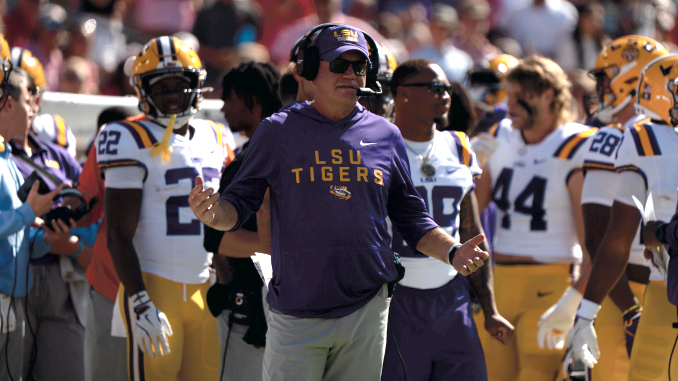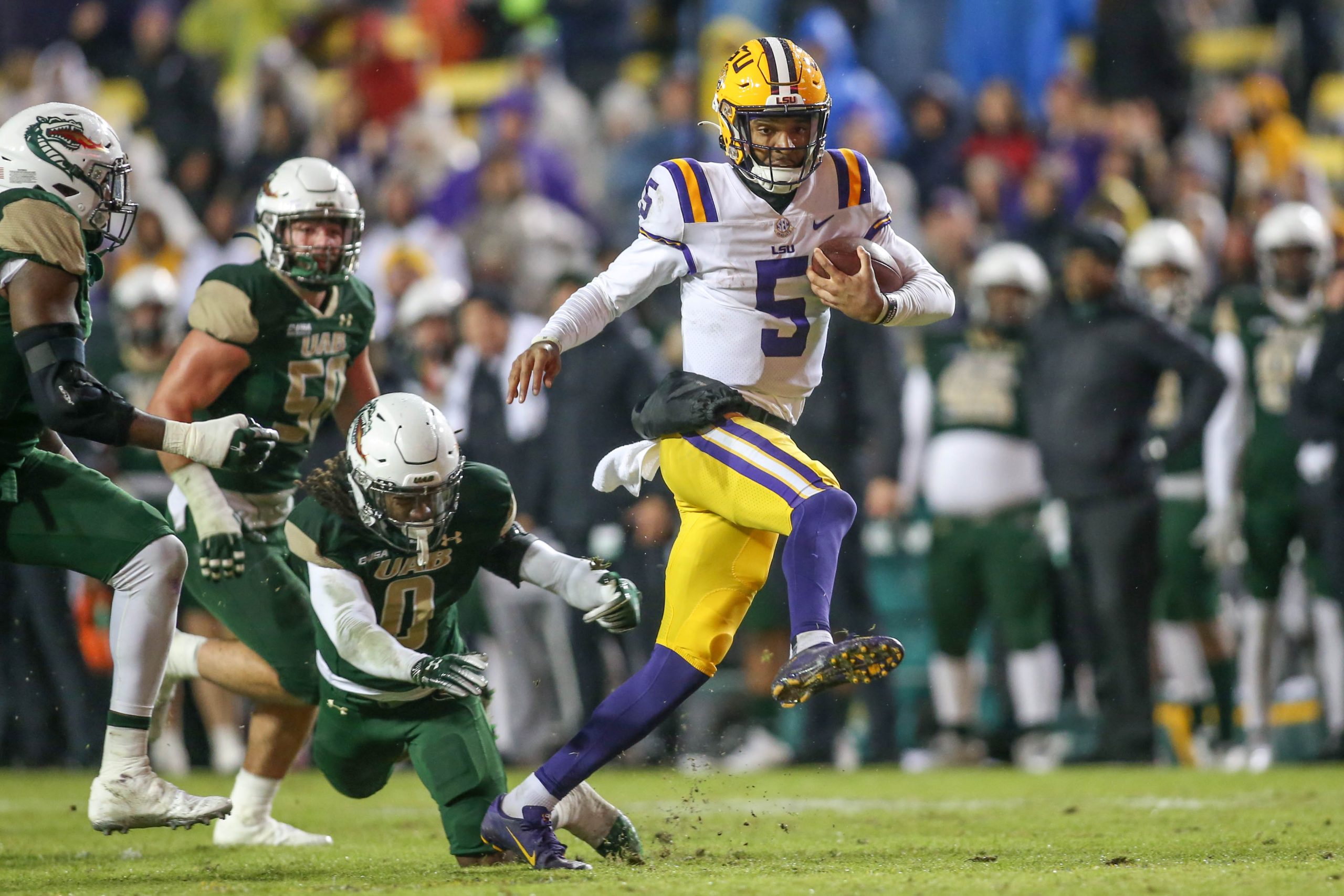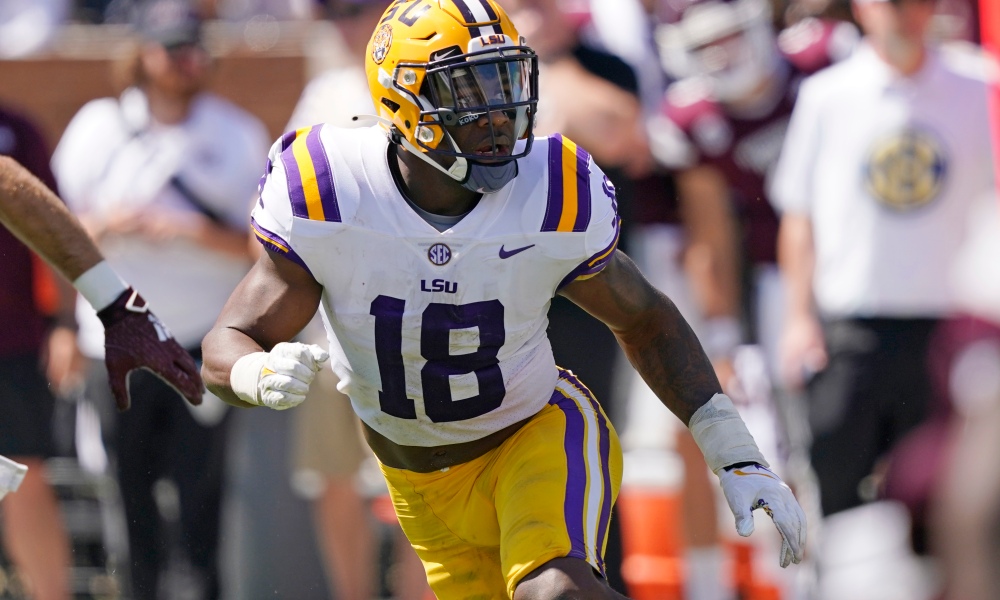
By TODD HORNE, Executive Editor
Brian Kelly arrived at LSU in 2021 with a hefty $10 million a year salary and a clear mission: restore the Tigers to national prominence after their 2019 championship high and subsequent fall. This season marks the first full infusion of an $18 million NIL investment into a roster brimming with blue-chip talent, raising expectations to fever pitch. On October 18, 2025, those hopes lie in tatters following a stunning 31-24 loss to Vanderbilt—the program’s first defeat to the Commodores since 1990.
Kelly’s overall record now stands at 34-13 (19-9 in the SEC), a tally that looks solid at first glance but crumbles under scrutiny: a middling 7-7 mark in true road games, including this Vanderbilt debacle, and a dismal 5-10 ledger against AP Top 25 opponents at LSU.
Respectable on paper, perhaps, but emblematic of a deeper issue: a coaching style that prioritizes measured process over the raw aggression the SEC demands.
The Vanderbilt game exposed these flaws in stark relief. Despite LSU’s financial and talent advantages—outspending Vandy by a reported $10 million and boasting far more NFL-caliber players—the Commodores dominated physically, outrushing the Tigers 239-100 and converting 8 of 16 third-and-fourth down situations to LSU’s meager 5 of 11. Kelly’s decisions turned potential momentum into missed opportunities, but let’s zero in on the culprits: the offensive coordinator’s baffling play-calling and an inexplicably porous offensive line that has plagued the Tigers all season.
Start with the play-calling malpractice. Trailing 31-17 in the fourth quarter with 11:39 left, Caden Durham burst 51 yards to Vanderbilt’s 2-yard line—a prime setup for a tying score. What followed was a sequence of head-scratching calls from offensive coordinator Joe Sloan that screamed hesitation over going for it. A conservative run for rhythm netted just a yard from Durham; a false-start penalty on Donovan Green erased a touchdown pass on second down; a direct snap to Ju’Juan Johnson stalled on a repeated second down; and a hurried and harried incomplete throw on third forced a mere 23-yard field goal, closing the gap to 31-24 but leaving seven points on the table. Sloan’s reluctance to dial up play-action fakes or quick slants against Vandy’s front—while the ground game wheezed at 3.2 yards per carry—felt like sabotage.
Then there’s the late-game punt, a revealing snapshot of Kelly’s eroded trust in his own offense—and a haunting echo of his infamous 2022 Texas A&M collapse. Down seven with 3:12 remaining and facing fourth-and-8 from their own 22, the defense had shown signs of life earlier in the fourth quarter by forcing a pair of Vanderbilt punts in the preceding nine minutes, hinting at one more stop to get the ball back with a shot at the end zone.
Analytics, however, painted a clearer picture of the opportunity squandered: In a neutral matchup (evenly matched teams, no timeouts specified), models like those from College Football Data estimate LSU’s pre-decision win probability at around 22%. Going for it on fourth-and-8 carries a ~36% conversion rate based on historical data for similar distances (per Wharton Sports Business analytics), jumping the win probability to ~55% upon success (now first-and-10 at the Vanderbilt 44, down seven with ample time) or dropping to ~8% on failure (turnover deep in opponent territory). The expected value? A boosted 28% win probability—six points higher than punting. Punting, assuming a solid 35-yard net to the Commodores’ 43-yard line, cedes possession and sinks the odds to ~18%, as Vanderbilt could kneel or run clock with ease. Kelly waved it off, punting to “bank on another stop,” but it laid bare his lack of confidence in Sloan’s sputtering unit to convert even a modest first down.
This mirrors the 2022 Texas A&M debacle in College Station almost beat-for-beat—a punt that gifted an upset to a desperate foe and torpedoed LSU’s playoff dreams. Trailing 31-23 with 4:18 left in College Station, LSU faced fourth-and-7 from its own 28 after sputtering for three yards on three plays. Jayden Daniels had been sharp (22-of-30, 189 yards), and the run game hummed at 4.2 yards per carry, yet Kelly punted 48 yards to the Aggies’ 24, citing red-zone woes and faith in a defense that had already surrendered 380 rushing yards (including Devon Achane’s 215-yard explosion). Analytics there were equally damning: Pre-decision win probability hovered at ~25%, with going for it offering a ~42% conversion chance and expected value of 32% (up from punting’s 15-18%). Instead, Texas A&M marched 76 yards in 11 plays, converting two third downs en route to Conner Weigman’s 21-yard TD strike to Moose Muhammad III with 22 seconds left, ballooning the score to 38-23 and igniting a field-rushing frenzy. Kelly called it a “calculated risk,” but it was timidity incarnate—over-trusting a leaky D while benching an offense primed to flip the script.
But how does this unravel when the offense can’t sustain drives in the first place? Enter the elephant in the backfield: LSU’s offensive line, a shocking embarrassment for a unit coached by Kelly, the self-proclaimed guru of trench warfare. A career offensive line whisperer who molded four first-round picks at Notre Dame—including Hall of Famer Zack Martin—Kelly entered LSU touting his expertise in building mauling fronts. Yet this 2025 group? A pressure cooker. They’ve faced a hurry on virtually every snap, averaging a league-bottom 3.8 yards before contact on runs, and collapsing in pass protection during Vanderbilt’s rush-hour clinic—turning routine drops into frantic scrambles for quarterback Garrett Nussmeier. How does a lineman factory like Kelly oversee such constant chaos—recruiting misses, scheme mismatches, or just plain undercoaching? The $18 million NIL boost was supposed to fortify the trenches, not turn them into a perpetual panic room.
Defensively, Kelly’s unit—bolstered by high-profile transfers—showed flashes amid the frustration, like West Weeks’ crucial 4th-down stop late in the second quarter that gifted LSU prime field position and a field goal to trim the lead to 14-13. But those moments were mirages in a desert of dominance: Vanderbilt punted just twice all game (both in the fourth), feasting on sustained drives—including a 14-play, 75-yard TD march early in the second, a brisk drive to a field goal before halftime (17-13 lead), and a pair of 10-play, 75-yard TD jaunts in the third to balloon it to 31-21. Without consistent disruption, the Tigers’ run-stop and pressure blueprint crumbled against Pavia’s mobility, allowing 8 of 16 conversions on crucial downs and those 239 rushing yards. LSU ranks seventh nationally in scoring defense (18.7 points per game allowed) but a middling 45th in total yards conceded, a gap that talent alone can’t bridge without tactical flexibility.
This loss isn’t an outlier; it’s the 2025 season in microcosm. Three weeks earlier, Ole Miss edged LSU 24-19 in a game where early pass-heavy play-calling left quarterback Garrett Nussmeier hanging in the wind and tanked red-zone efficiency (1 touchdown on 4 trips). The 20-10 win over South Carolina offered fleeting hope through aggressive fourth-down calls, but it masked broader offensive woes: The Tigers sit 62nd nationally in total offense (385 yards per game) and convert just 28% of third downs, plagued by predictable schemes that fail to maximize their talent advantages.
Kelly excels at recruiting top talent and fostering a drama-free culture, assets that have kept LSU competitive. Yet in the SEC’s unforgiving arena, where wins thrive on execution, his measured philosophy yields likely 8-4 finishes rather than playoff breakthroughs—a pattern reminiscent of his conservative calls in Notre Dame’s 2013 National Championship loss. Fan frustration boiled over with “Fire Kelly” chants at FirstBank Stadium, and even with a $53 million buyout clause, once perceived to be too high to hurdle, the pressure now mounts.
The path forward is brutal: Five straight wins against Texas A&M, Alabama (on the road), Oklahoma (on the road), Arkansas, and Western Kentucky to reach 10-2 and CFP contention.
Succeed, and Kelly regains breathing room.
Fail, and the reckoning arrives.
Brian Kelly has fundamentally altered LSU’s identity and not for the better. The team isn’t just losing; it’s being out-toughed and out-physicaled every week. He’s replicated the exact culture he left at Notre Dame: technically polished, emotionally hollow, and completely devoid… https://t.co/OHLD4AQbhK
— Mike Ross (@standtalkla) October 19, 2025
The odds of LSU now making the CFP are virtually nonexistent—with ESPN’s FPI dropping the Tigers’ playoff probability to a mere 6.2% post-loss, down from 32.7% entering the game—the margin for error has evaporated, turning every snap into a referendum on Kelly’s tenure.
LSU invested heavily for a proven winner, not a professor of patience. It’s looking like it’s time for Kelly—LSU’s Yankee Doodle Dandy—to take his bag of $53 million, stick a feather in his cap, call it macaroni and geaux back home.




Be the first to comment